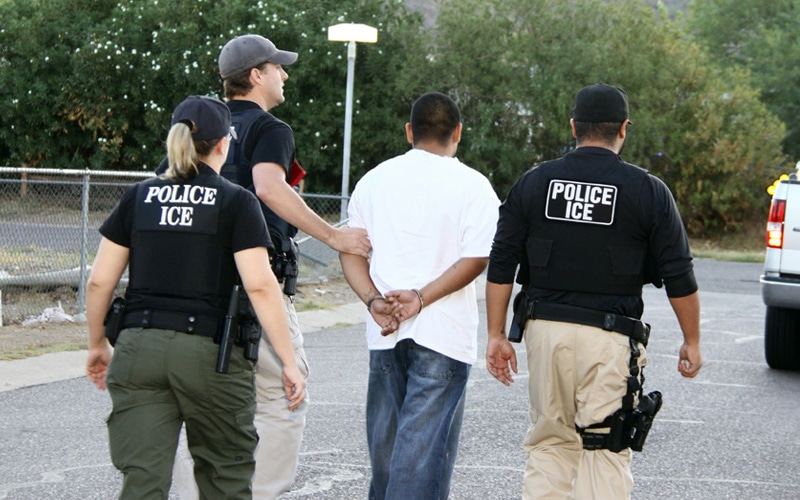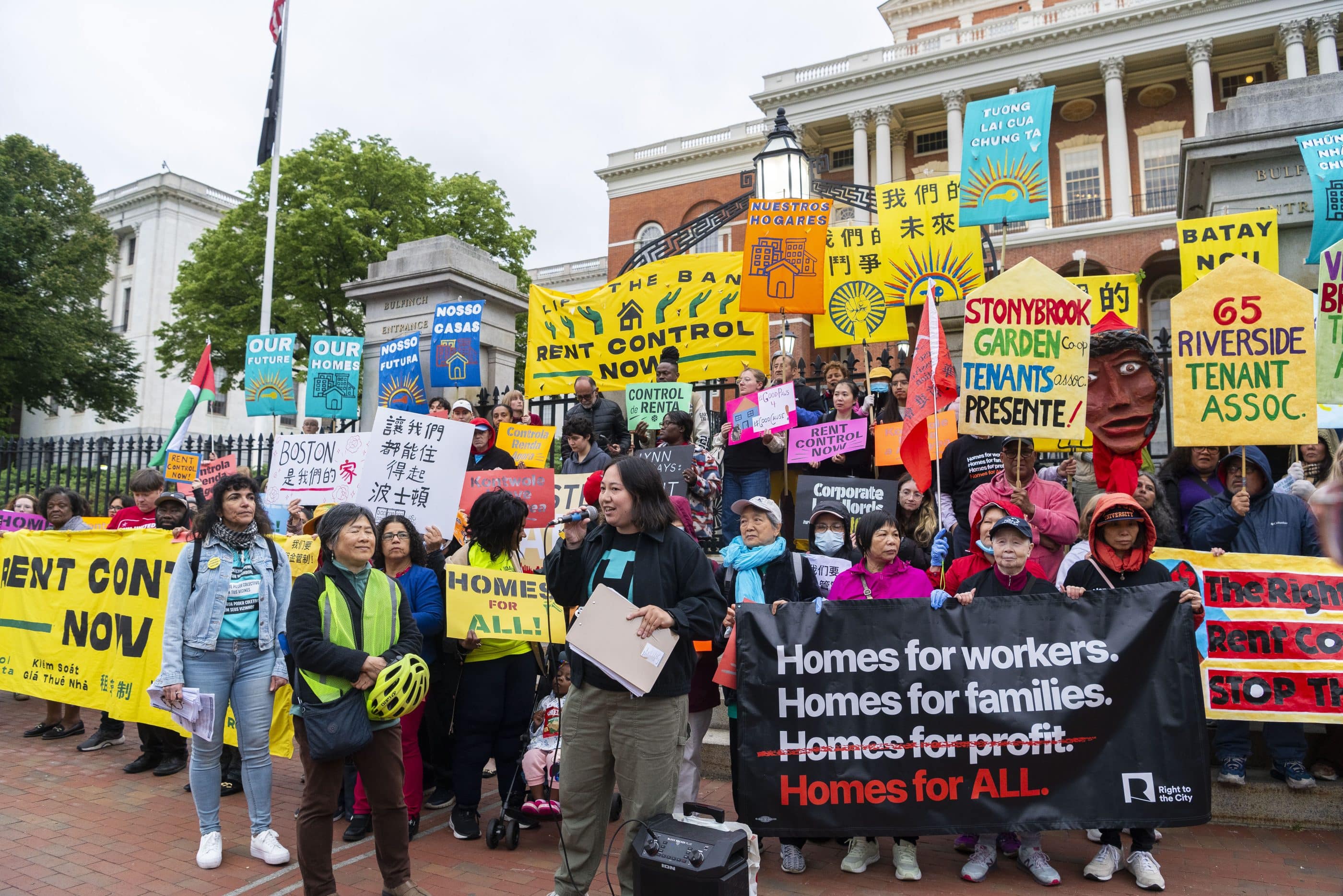Immigrant communities in the United States are on edge. And rightly so—President Donald Trump’s racist rhetoric and draconian deportation policies are wreaking havoc on folks’ sense of security. As a result of the fear mongering, families are going into hiding, says Adriana Quintero, a leader at The Family Center/La Familia, a nonprofit dedicated to supporting the immigrant community in Fort Collins, Colorado.
“Kids, they don’t want to go to school, because they feel like, ‘Papi, do you think they’re going to send you back to our country?’” Quintero says. “Nobody wants to go to the doctor. Nobody wants to go driving. Nobody wants to do a lot of things because they’re scared right now. They don’t know how to navigate these things.”
Quintero, who’s been an advocate for the Northern Colorado immigrant community for two-plus decades, says that while ICE has always been a looming threat, fear has intensified within the immigrant community as Trump’s campaign promises of mass deportation become administrative policy. People are so frightened—even those whose legal status is well documented—that in the months since Trump took office, employees at La Familia have watched clients retreat from day-to-day activities. In response, the organization has ramped up its support and protection efforts.
“It’s not just doctors and rides. It’s getting people to safety. It’s getting documentation. It’s getting attorneys—there’s so much. It’s training people for rapid response. Everybody’s busy. We can’t even do public events now, because we’re worried about ICE,” says Samantha Stegner, an activist and project manager at La Familia. “If people aren’t even willing to go to the doctor, it’s making our jobs even harder because they’re not going to turn their managers in [for housing violations]. I mean, we’ve had people literally empty homes and walk away.”
Of course, this situation is repeating itself nationwide. Folks are scared, says Eric Dunn, director of litigation for National Housing Law Project, a housing justice advocacy nonprofit. “We definitely have had a major spike in people concerned about this and wanting to know what do if ICE comes knocking,” he says. “Pretty much since the inauguration, we get emails or calls about that pretty consistently.”
So, as a property owner, landlord, employee, or resident of multifamily affordable housing, have you considered what you’d do if ICE agents showed up, trying to find a resident? Understanding your relationship to ICE, your rights and obligations when it comes to following the law, and how your reaction to ICE’s demands can affect immigrant communities is essential to protecting your immigrant tenants, constituents, or neighbors. And as ICE crackdowns intensify, it’s more important than ever to have a clear plan in place. If you don’t have a plan in place already, you should create one. (None of the following is legal advice. Please be in touch with a local lawyer who understands your state laws and your organization’s specific circumstances.)
What Should You Do?
In Washington state, ICE is certainly on Andy Silver’s radar. Silver is executive director at the Vancouver Housing Authority (VHA). While the organization is used to dealing with law enforcement, ICE raids have not historically been an issue. But the aggressive escalation of immigration enforcement and general harassment of anyone who’s perceived to possibly be an immigrant—especially those of Native, Latin American, or Middle Eastern appearance—immediately following Trump’s inauguration were dramatic enough that, just this year, VHA created organization-specific procedures employees should follow if they’re confronted or questioned by law enforcement, including ICE. And although ICE agents haven’t yet raided any VHA properties, Silver and his staff felt it was necessary to capture in writing what employees should and shouldn’t do if confronted by ICE, or even by local or state police. “The information we have is protected. So unless they can give us a search warrant or a subpoena, then we have to sort of politely decline,” Silver says. “And since [the procedures are] geared towards staff, it tells them how to escalate it so that we’re not putting them in a situation where they’re having to look at legal documents and make that determination on their own.
On Feb. 10, right after the federal funding freeze, Tamara Flanders, housing director of the YWCA of Northeastern New York, told Shelterforce that in the midst of funding uncertainties they had also had to train their front desk staff on this topic. “We’re a 24-hour facility,” she said in an email. “So last Friday, we were, between 7am and 10pm, training staff on rotation on how to identify a judicial warrant from an admin warrant and securing public and private space within our buildings and on the property. . . Our front desk staff, some of them are 18, 19 years old, you know. The idea of them standing up to ICE is intimidating. So we’ve made up a script card for them to even hand to ICE if they’re nervous and they can’t remember what they’re supposed to say. . . . We’ve got our on-call rotation and our director staff ready to come in. Chances are slim somebody would show up here with a judicial warrant. But we do want to be prepared if that happens.”
Unfortunately, there aren’t nationwide best practices for dealing with law enforcement looking for folks to detain or deport because laws vary from state to state, Dunn says, so what’s recommended in California may not be the right move in Missouri. Folks interested in understanding what local ICE agents can and can’t do, as well as what rights immigrant residents and allies have to withhold cooperation, should contact a local advocacy group or consult an attorney. No matter what may be allowed or disallowed by state or local laws, there are three recommendations Dunn believes apply to every situation:
- Designate common areas as private spaces: If property, including a multifamily building lobby, courtyard, or other typically common area, is marked as being closed to the public, ICE agents cannot enter without a warrant. “So, for example, if you’ve got an apartment building, and the lobby doors are unlocked, anybody can enter the lobby. But, to go past the lobby, if they need to have a key card, or it’s marked ‘residents only’ or something, then they’re not allowed to enter those types of areas without either [a warrant or] permission from somebody who has the right to give it—that would usually be either a tenant or, if it’s a common area, it could be the owner. But they can’t just go in to the private areas,” Dunn says. “So one step is to make sure that in multifamily-type buildings, any common areas are marked with signage or barriers and fences to make clear which parts are public space and what parts are private areas so that ICE agents can’t just start walking up and down the halls looking for people.” Unfortunately, Trump’s racist rhetoric and deportation actions have emboldened ICE agents, who’ve been documented disregarding private spaces and declining to produce warrants. Additionally, although adding signage—such as “Restricted Area: Residents and Employees Only”—is a good idea, Public Counsel, a nonprofit public interest law firm focused on civil rights and racial and economic justice, cautions that “signs alone may not make an area legally private.” It’s recommended that building owners work with an attorney to draft legally defensible policies.
- Check if the warrant is signed by a judge: ICE officials and immigration judges can issue administrative warrants, which authorize the named person’s arrest and detention if there is probable cause to believe they’ve committed an immigration violation, e.g., they’re undocumented or do not have legal paperwork. But an administrative warrant does not give ICE permission to enter private property without admission by the property owner—only a judicial warrant (one issued and signed by a judge) permits that. “So, if ICE finds the person and they have that administrative warrant, they can arrest them. But it doesn’t give them the ability to enter private property looking for someone. So property owners have to look and see if [the warrant] has the seal of a U.S. district court. Is it issued by a judge, or is it from an immigration official? If it’s from an immigration official, it’s not a search-and-seizure type warrant.” This fact sheet published by the National Immigration Law Center (NILC) explains that a judicial warrant will be issued by a judicial court, signed by a magistrate or judge, and will include the name of the district, state, or federal court, such as “Superior Court of [state name]” or “U.S. District Court.”
- Discard tenant immigration status information: ICE can get judicial subpoenas and use them to request documents from landlords. “So for example, if they think that there might be undocumented people living at a particular building, they could potentially seek a subpoena and force that landlord to turn over information—files or something—which could have information about people’s immigration status,” Dunn says. “For the most part, there’s not really a reason for landlords to even have that information on hand . . . It creates a risk that ICE could potentially obtain that information if they were to serve a subpoena. So if you don’t want to have to get subpoenaed and deal with that, don’t keep that kind of information.” Similar to warrants, ICE agents may present either a judicial or an administrative subpoena, according to NILC. Judicial subpoenas are issued by a judicial court and must be complied with. Administrative subpoenas do not carry an immediate requirement to comply, nor do they authorize entrance onto the premises.
What Shouldn’t You Do?
When asked if taking any of those actions could get someone in trouble, Dunn (who is not a criminal attorney) stressed that refusing to cooperate with law enforcement is not illegal. If the agents don’t have a signed judicial warrant, you don’t have to acquiesce to their requests. You don’t have to volunteer information or let them on the property. In fact, you don’t even have to talk to them.
“There’s no obligation to answer questions, and it’s probably safer just to refuse to answer,” he says. “And if you answer, answer truthfully.” It is illegal in some cases to lie to federal agents, he says.
There are anti-harboring statutes on the books in most places, which make it illegal to purposefully conceal people law enforcement is searching for. “But my understanding is that somebody has to go pretty far to violate that,” Dunn says. They have to “actually be purposefully concealing and preventing ICE from lawfully apprehending the person.” Ensuring ICE follows the law does not count.
If ICE shows up, Dunn recommends video recording any interactions, especially if law enforcement doesn’t leave when asked, or if they otherwise do something you think violates the law. Agents cannot lawfully prevent citizens from recording their activity as long as it’s from a safe distance and the person filming isn’t interfering with ICE’s activities. “If there’s no recording and there are any kind of proceedings afterward, there could be disagreements [about what happened].”
If you couldn’t get a video, make a written statement yourself right away and get a written statement from any witnesses, he says. Then, contact legal representation. Although it’s difficult to sue federal officials and win monetary compensation, Dunn says, suing to get property back (such as confiscated tenant records) or ensure something doesn’t happen (by getting an injunction or restraining order) is an easier lift.
While securing legal aid is important, La Familia’s Stegner, who’s white, says she thinks that building trust within immigrant communities is also key—especially for white allies who are citizens. But she adds that immigrant communities, especially when facing external threats, can be insular and wary of help from people outside their circle of trust, which is why it’s important to meet them where they’re at and in ways that make them feel heard and safe. “Learn to communicate,” even if you can’t speak someone’s language, she says. “You’re not going to find ways in, you’re not going to have those conversations, without trust.” She notes that a lot of the board members at La Familia are white, but that they are committed to stepping up to protect their residents.
When confronted by law enforcement, Stegner says, she asks a lot of questions such as, “What are you doing here? Who are you looking for?” It is important, given the fear rippling through the community, to get specific, accurate information, Quintero says. It’s also important to be careful how you share information. Rumors and unverified claims spread easily and can traumatize an entire community.
“Right now, if you hear something, no matter whether it is true or not, you believe it. And then you pass it to the whole community, and you scare the whole community,” she says, describing a recent situation in which a community member sent a group text message that a communitywide event had been canceled because folks had seen ICE agents in the area. “She was trying to protect the communities, telling families be careful today. But it’s received as scary. Maybe [people] can switch their vocabulary—don’t put ‘la migra’ [i.e., ICE] in so people want to go into hiding.” Along with offering information on the rights of people who are stopped or questioned by ICE, immigrant rights groups suggest sharing factual, detailed information about ICE sightings with local advocacy groups, which can communicate with their constituents in ways that don’t prompt panic. When passing along info, these groups suggest using the S.A.L.U.T.E. acronym to make sure you document all relevant information:
- S is for size: How many agents are in the group?
- A is for activity: What are the agents doing?
- L is for location: Where are the agents?
- U is for uniform: What are the agents wearing?
- T is for time: What is the date and time of day?
- E is for equipment: Do the agents have weapons?
While everyone is frightened and uncertain, there have been unintended positive side effects to the deportation threats and fear, Stegner says. “I feel like it’s almost made our community stronger, in a sense. People are trying to help make sure people are safe, gatekeeping [against ICE] a little bit, double-checking, verifying. There can be a lot of division in our cultures, and I feel like this is bringing everyone together, remembering, ‘Hey, we’re all here. Let’s look out for each other and do what we can.’”
Additional reporting contributed by Miriam Axel-Lute.





Frightening times as the authoritarian terror, fueled by racism is running rampant. Thanks for your reporting.